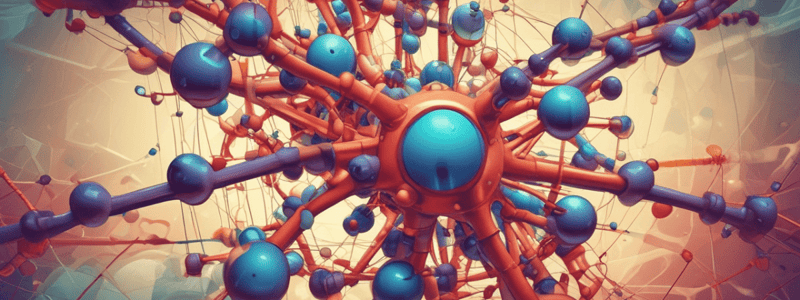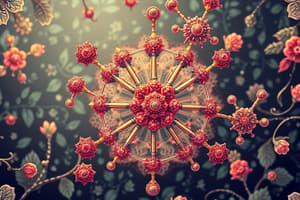Podcast
Questions and Answers
Who first introduced the concept and term 'supramolecular chemistry'?
Who first introduced the concept and term 'supramolecular chemistry'?
- A. W. G. Cairns-Smith
- J.M. Lehn (correct)
- L. Pauling
- R. Hoffmann
Which of the following interactions is not typically considered an intermolecular force in supramolecular chemistry?
Which of the following interactions is not typically considered an intermolecular force in supramolecular chemistry?
- Hydrogen bonding
- Van der Waals interactions
- Covalent bonding (correct)
- π-π stacking interactions
What is a key characteristic of supramolecular species compared to molecules?
What is a key characteristic of supramolecular species compared to molecules?
- More flexible dynamics (correct)
- Higher melting points
- Stronger bonds
- Highly localized electrons
Which of the following best describes the idea behind supramolecular chemistry according to Lehn?
Which of the following best describes the idea behind supramolecular chemistry according to Lehn?
Which intermolecular force involves π-π stacking interactions?
Which intermolecular force involves π-π stacking interactions?
Which of the following is a true statement about intermolecular forces in supramolecular chemistry?
Which of the following is a true statement about intermolecular forces in supramolecular chemistry?
Which interaction has the highest bond energy?
Which interaction has the highest bond energy?
What is a characteristic of molecular recognition?
What is a characteristic of molecular recognition?
Which category of molecular receptors is responsible for binding cations via electrostatic ion-dipole interactions?
Which category of molecular receptors is responsible for binding cations via electrostatic ion-dipole interactions?
Which substance incorporates softer atoms like N, S, P to bind strongly with transition metal ions?
Which substance incorporates softer atoms like N, S, P to bind strongly with transition metal ions?
Which type of host is specifically designed to remove Li+?
Which type of host is specifically designed to remove Li+?
Which molecule shows greater selectivity for K+ among alkali and alkaline-earth cations?
Which molecule shows greater selectivity for K+ among alkali and alkaline-earth cations?
What advantage do lariat ethers have over crown ethers?
What advantage do lariat ethers have over crown ethers?
Which interaction type has the weakest bond energy?
Which interaction type has the weakest bond energy?
What affects the selectivity of cation binding?
What affects the selectivity of cation binding?
What is a characteristic feature of cyclodextrins?
What is a characteristic feature of cyclodextrins?
Which of these is not a factor affecting cation binding?
Which of these is not a factor affecting cation binding?
What type of interaction is observed in calixarenes?
What type of interaction is observed in calixarenes?
Which host molecules are used for anion recognition?
Which host molecules are used for anion recognition?
Which type of host molecules are cavitands?
Which type of host molecules are cavitands?
Which of the following is an example of a macrocyclic polyamide anion receptor?
Which of the following is an example of a macrocyclic polyamide anion receptor?
Why are anions generally large, and what does this imply for their receptors?
Why are anions generally large, and what does this imply for their receptors?
What term is used for components that undergo self-assembly?
What term is used for components that undergo self-assembly?
Which type of self-assembly is characterized by dynamic and reversible interactions?
Which type of self-assembly is characterized by dynamic and reversible interactions?
Who introduced the concept of metallosupramolecular chemistry?
Who introduced the concept of metallosupramolecular chemistry?
In the context of metallosupramolecular chemistry, what do metal ions provide?
In the context of metallosupramolecular chemistry, what do metal ions provide?
What type of helicates was introduced by Lehn in 1987?
What type of helicates was introduced by Lehn in 1987?
What is the structural characteristic of a rotaxane?
What is the structural characteristic of a rotaxane?
Which type of coordination geometry is not associated with double stranded helicates?
Which type of coordination geometry is not associated with double stranded helicates?
Who introduced the concept of catenanes, and what do they involve?
Who introduced the concept of catenanes, and what do they involve?
What common attributes are shared by components in molecular devices?
What common attributes are shared by components in molecular devices?
What is the coordination number (CN) and shape for Cu(I)?
What is the coordination number (CN) and shape for Cu(I)?
Which year was the Nobel Prize in Chemistry awarded for the design and synthesis of molecular machines?
Which year was the Nobel Prize in Chemistry awarded for the design and synthesis of molecular machines?
In molecular machines, what input is required for them to perform a task?
In molecular machines, what input is required for them to perform a task?
What motion is observed with an electric car powered by nanoscale molecules?
What motion is observed with an electric car powered by nanoscale molecules?
Which of the following molecules have a coordination number (CN) of 6 and exhibit octahedral symmetry plus Jahn-Teller distortion?
Which of the following molecules have a coordination number (CN) of 6 and exhibit octahedral symmetry plus Jahn-Teller distortion?
What kind of motion does the term 'pirouetting' describe in the context of molecular devices?
What kind of motion does the term 'pirouetting' describe in the context of molecular devices?
What are some potential applications of molecular machines as speculated by researchers?
What are some potential applications of molecular machines as speculated by researchers?
Study Notes
Bond Energies
- Single bond energy: 350 KJ/mol
- Triple bond energy (N2): 942 KJ/mol
- Ion-ion interactions: 250 KJ/mol
- Hydrogen bonding: 20 KJ/mol
- Dispersion forces: 2 KJ/mol
Host-Guest Chemistry
- Early example: selective binding of alkali metal cations in crown ethers and cryptands
- Molecular recognition: selective binding of a specific substrate to a receptor
- Self-assembly process: self-organization of molecular system via molecular recognition
Molecular Recognition
- Geometrical preorganization and interaction complementarity
- Preorganization: construction of host that exactly matches with guest (both sterically and electronically)
- Complementarity: host must have binding sites that attract binding sites of guests
- Interactions are relatively weaker than covalent bonds, but multiple site interactions yield strong selective complexation
Molecular Receptors (Hosts)
- Cation binding hosts
- Anion binding hosts
- Neutral molecule binding hosts (inorganic, organic, or biological)
Cation Binding Sites
- Bind via electrostatic ion-dipole interaction
- Examples: crown ethers, lariat crown ethers, heterocrown, spherands, cryptands, calixarene
Cation Binding Hosts
- Binding by electrostatic ion-dipole interaction
- Better the fit of the cation into the crown, the stronger the complex: optimal spatial fit
Lariat Ethers
- Designed to carry and transport cations across lipophilic membranes
- Higher binding constants than crown ethers
Heterocrowns
- Incorporation of softer atoms: N, S, P
- Binding to Ag+ and transition metal ions
- Strong complexation of toxic Cd2+, Pb2+, Hg2+ ions
Spherands
- Macrocyclic host with rigid cavity
- High stability Li+ complex (size fit)
- Used for removal of Li+
Cryptands
- Macrocyclic ligands that form a 3-dimensional cage to encapsulate (hide) the metal ion
- Special recognition for alkali and alkaline-earth cations
- Selectivity of K+ is observed for [2.2.2] 104 times stronger than its crown analog
Supramolecular Chemistry
- Definitions:
- Chemistry beyond the molecule, bearing organized entities of higher complexity that result from the association of two or more chemical species held together by intermolecular forces
- Chemistry of species made of two or more molecular components
- Introduced by Lehn in 1978
- DNA backbone: example of supramolecular chemistry
Intermolecular Bonds
- Hydrogen bonding
- Electrostatic forces
- Van der Waals interactions
- Donor-acceptor interactions
- π-π stacking interactions
- Metal ion coordination
- Bond energy comparison: intermolecular forces are generally weaker than covalent bonds
Calixarenes
- Act as host for cations, anions, and neutral molecules depending on the degree of functionalization
- π-cation interaction also observed
Selectivity of Cation Binding
- Several factors:
- Size match between cation and host cavity
- Electrostatic charge
- Solvent (polarity, hydrogen bonding, coordination stability)
- Degree of host preorganization
- Enthalpy and entropy contribution
- Cation and host free energies of solvation
- Nature of counter-anion
- Interaction of counter-anion with solvent and the cation
- Cation binding kinetics
- Chelate ring size
Anionic Recognition
- Simple inorganic anions occur in a range of shapes and geometries (spherical, linear, planar, tetrahedral, octahedral)
- Positively charged hosts:
- Polycyclic-amide ligands
- Macrocyclic tetraamide
- Katapinands (swallow up)
Neutral Molecules Recognition
- Cavitands: host molecules with intrinsic cavity present in both solid-state and solution
- Examples: calixarene, cyclodextrines, cucurbituril
Supramolecular Chemistry, Metallosupramolecular Chemistry, and Molecular Architecture
- Definitions
- Molecular recognition
- Self-assembly
- Metallosupramolecular chemistry
- Encapsulated guests in metallonanostructures
- Molecular devices and machines
Metallosupramolecular Chemistry
- Introduced by E.C. Constable
- Non-covalent interaction: coordinative bonds
- Metal ions provide:
- Set of coordination geometries
- Range of binding strengths (from weak to strong)
- Range of formation and dissociation kinetics (from labile to inert)
Helicates
- Introduced by Lehn (1987)
- Tetrahedral versus octahedral coordination in double-stranded helicates
- Triple-stranded helicates
- Cyclic helicates
- Grid-type metal ion architectures
- Polygons
- Polyhedra
Supramolecular Devices and Machines
- Defined as complex systems made up of molecular components with definite individual properties
- Common components in molecular devices are photochemically, redox, or chemically active molecules
- Examples:
- Pirouetting of ring in a catenate
- Translation in rotaxanes
- Contracting and stretching motion
- World’s smallest electric car (animation)
- Electrically driven directional motion of a four-wheeled molecule on a metal surface
Studying That Suits You
Use AI to generate personalized quizzes and flashcards to suit your learning preferences.
Related Documents
Description
Test your knowledge of supramolecular chemistry, including definitions, molecular recognition, self-assembly, and metallosupramolecular chemistry. Learn about encapsulated guests in metallonanostructures and molecular devices and machines.




